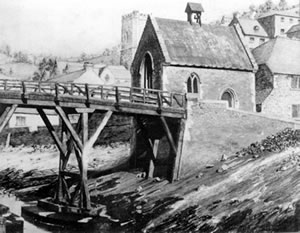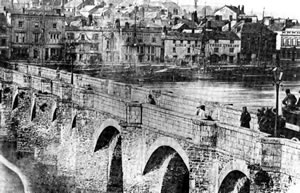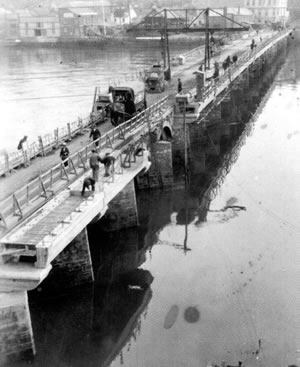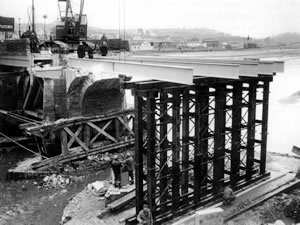History
The history on this page is taken from 'The Long Bridge of Bideford' by Peter Christie BA(Hons), MPhil & Frank E.Whiting FRIBA.
'The Long Bridge of Bideford' book is available from the Trust Warden at Bideford Bridge Trust, First Floor Offices, 4 Bridgeland Street, Bideford, Devon, EX39 2PS - it costs £2.50 plus postage. Please contact them direct to obtain a copy.
Here is very edited version of the book. There is much more detail and associated information in the book itself.
A Brief History of the Bridge

The original structure of Bideford bridge was of oak and it remained a timber bridge for just over two hundred years. The main supports were built up from a timber plate resting on a rough stone foundation. These supports were of oak about 12 inches square.
Between 1400 and 1500 appeals were made on five separate occasions for repairs and reconstruction. In 1459 the Pope issued a letter for repairing 'The bridge of Bideford on account of the faulty structure of the said bridge which is of wood.' In the 1925 repairs this original oak was discovered and used to make a large ornamental chair for the chairperson of the Bridge Trust. Sets of candlesticks were made and presented to various townspeople.
Like most medieval bridges Bideford bridge had chapels at either end. Each chapel would probably have had a clergyman attached to it and who would have been paid by the Bridge Trust or by a wealthy local.
The First Stone Bridge
The first stone bridge was built over and around the original wooden structure. The original twenty-four arches were replicated in the new material with the width of the new stone arches varying between 12 and 25 feet.

The large Maltese Cross bearing a carving of the Virgin and Child on the south parapet was probably included when the stone bridge was created. The cross is thought to have been taken down in 1638 when the bridge was repaired.
Around 1690 a sundial was erected on the downstream parapet in the centre of the bridge.
In the Trust's account books from the 1680s are entries about the purchase of 'windlasses': these were sticks of hazel or holly woven into a kind of basket and anchored around the base of the piers by wooden stakes driven into the riverbed to protect the piers from being undermined.
East-The-Water circa 1745
The book �Maps of Bridge Lands, drawn 1745' shows a toll house, chapel, blacksmith's shop, stables, a lime kiln and another small shop.
The toll house was typical of the period whilst the lime kiln was circular in shape unlike others of square shape found around the North Devon coast.
Widening the Bridge 1795-1811

Over the years 1795-1811 intermittent work was carried out to widen the bridge by 4 feet by constructing semi-circular arches against the spandrels of the pointed arches on each side of the bridge. At the same time as the bridge was being widened the parapets were rebuilt using Penarth Ashlar stone.
The Second Widening 1846-1866
In 1846 three different railway companies applied to the Trust for permission to cross bridge land with their tracks which prompted moves to widen the bridge yet again. A number of schemes were discussed and various plans prepared with a competition begun in 1855 to secure the best design for a new, wider bridge.
The actual work took place between 1864 and 1866 and saw the width of the roadway increased, utilising iron and steel rather than stone. The wider road was surfaced with Portgain granite from Pembrokeshire.
The Third Widening 1898-1925
In 1912 the trustees commissioned a report on the condition of the bridge. By this time some of the cutwaters had become so bad that emergency repairs had already been carried out. The trustees accepted the suggestions in the report but the First World War interrupted the work which was only finally completed in 1925. When finished the roadway was 16 feet wide with 7 feet wide pavements.
For the first time the bridge was lit at night with lamp standards on both sides.
1925-2017
The newly widened and strengthened bridge continued to serve the town well both as a link between its two halves and also a tourist attraction. Tourism, however, halted in 1939 with the outbreak of war and over the next six years the bridge was guarded by the Bideford Home Guard against possible enemy attack. Its importance as a transport link to the West Country was endorsed with the discovery of German 'Invasion Plan' maps clearly showing the bridge as a target.
The exceptionally bitter winter in 1963 brought an added anxiety. So great were the baulks of ice from the frozen river that a party of unemployed men were engaged for several days in breaking them up to prevent damage.
A 1961 traffic census revealed that the bridge carried a daily flow of 8-9000 vehicles. Of this total it was estimated that heavy transport represented 10 per cent. By 1966 it was reckoned that the figures could well be increased by 25 per cent. Further repair work was completed in the summer of 1967.

On the evening of January 9th 1968 two women walking across the bridge heard mysterious noises 'like thunder', followed by splashes in the water below. Portions of the masonry were in the process of collapsing. Road and pedestrian traffic over the bridge was immediately halted by the police.
The town was now divided in two - the A39 trunk road being diverted in Cornwall. Complicating the situation was the fact that the bridge also carried main gas and water pipes and the trans-Atlantic telephone cable.
To meet pedestrian needs ferries were organised and the railway line was temporarily opened up for passenger traffic. Road vehicles were faced with long detours in order to cross the river.
A solution to the pedestrian problem was provided within ten days of the collapse by the construction of a temporary tubular foot bridge from the quay to the undamaged part of the bridge.
A temporary roadway was opened by the end of March and in the middle of the month the Ministry of Works took over the responsibility for and maintenance of the bridge subject to the Trust contributing �1000 a year in perpetuity.
This disaster strengthened calls for a new bridge. This meant that wear and tear on what is now a Grade 1 Listed Building was considerably reduced.
Some years later a 3 tonne weight limit was imposed (which excluded public service vehicles) whilst some have called for a third bridge upstream from the old bridge to relieve pressure on it.
The Bridge at Burton Art Gallery
The model of the Long Bridge and which was constructed by the Trust's former Warden Mr Frank Whiting shows the bridge as it looked through the various centuries and can be viewed in the Burton Art Gallery, Bideford.

